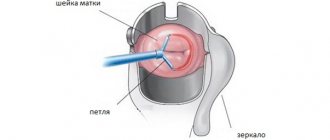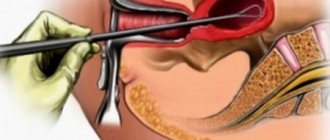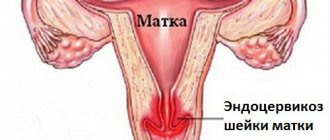With the development of pathological processes on the cervix, therapeutic measures should be carried out in a timely manner. Otherwise, women will have to face serious complications, in particular, cancer.
For each patient, the course of drug therapy should be selected by the attending physician, who, if there are grounds, may insist on surgical intervention.
Indications and contraindications for surgery
This surgical technique is used in the treatment of patients with cervical pathologies, the list of which can be expanded:
- tumor processes (benign nature),
- scars that deform the cervix,
- dysplasia,
- various precancerous conditions,
- malignant neoplasms at the initial stage of development,
- complications arising after ectopia,
- other cases in which the methods used to treat the cervix were ineffective.
Surgical treatment is not performed for patients with the following pathological conditions:
- diabetes,
- presence of a pacemaker,
- pregnancy,
- the first days of the monthly cycle,
- breastfeeding period,
- thrombocytopenia,
- infections affecting the urinary and reproductive system.
Surgical technique: how cervical excision is performed
The procedure is performed under local anesthesia. Lidocaine or other drugs are used to anesthetize the cervix. A mixture of anesthetic and vasoconstrictor drugs can be used. Injections are performed with a thin needle clockwise from the posterior lip of the cervix. This is usually enough to eliminate any discomfort. According to indications, the operation can be performed under general anesthesia.
On a note
Numerous reviews of women who have undergone loop excision indicate that the procedure is not too painful, but quite unpleasant. During tissue excision, you may feel a nagging pain in the lower abdomen, slight dizziness, and weakness. A small percentage of women indicate that the pain was quite severe. This is probably due to the individual sensitivity threshold or characteristics of pain relief. Much depends on the qualifications of the doctor who performed the operation.
Stages of cervical excision:
- The patient is in a gynecological chair. The doctor exposes the cervix in the speculum, fixes the instrument, removes discharge that interferes with the examination,
- A control colposcopy is performed, the boundaries of the lesion are established,
- A loop is selected - its shape and size will depend on the area of the lesion,
- The power of the device is set (the loop should not spark or get tied in the tissues),
- The cervix is fixed with bullet forceps beyond the border of the lesion,
- The doctor removes the affected tissue with a loop,
- The resulting material is sent for histological examination,
- Bleeding vessels coagulate,
- In case of severe dysplasia and suspected cancer, curettage of the cervical canal is performed.
Excision is a medical procedure that has both therapeutic and diagnostic purposes. The essence is to remove the epithelium affected by the disease on the cervix, and then conduct a histological analysis of the removed tissue to confirm or clarify the diagnosis.
In laboratory conditions, scraping of the cervical canal and removed tissues are examined under a microscope. Clean resection margins are a good sign, because in this case the doctor was able to remove the entire pathological focus. If altered cells are visible along the contour of the excised tissue, a new operation may be required. This means that the doctor has not captured the entire lesion, and there is a high probability of relapse.
On a note
Based on the results of histology of the cervix and cervical canal, re-treatment with an expansion of the scope of the operation may be recommended.
Preparation
Before performing surgical manipulations on the cervix of the uterus, the patient must undergo special training, which includes passing a number of basic and specific tests and hardware examination:
- Smears for cellular atypia and microbiocenosis.
- Colposcopy.
- Tests: HIV, hepatitis, syphilis.
- PCR diagnostics.
Preparation for the procedure
Loop excision of the cervix is performed in a one-day hospital setting. The operation is performed in the morning, after which the patient remains under the supervision of a doctor for two hours. If there are no complications, the woman can go home after 2-4 hours. If any problems arise, hospitalization in a 24-hour hospital is possible.
Before excision, it is necessary to undergo a complete examination:
- Blood tests: general, biochemical, coagulogram, determination of Rh factor and blood group,
- General urine analysis,
- Flora smear and bacteriological culture from the cervical canal,
- Oncocytology test,
- Screening for infections: HIV, viral hepatitis, syphilis,
- Tests for STIs (HPV and other microorganisms according to indications),
- Colposcopy,
- ECG and consultation with a therapist.
Oncocytology is a microscopic examination of a smear of cervical cells for the purpose of early detection of oncological pathology.
Two days before the procedure, you should avoid intimacy, do not use suppositories or douche. Taking any medications (primarily those affecting the blood coagulation system) should be discussed with your doctor.
It is important to know
Any manipulations can be carried out only after receiving the results of colposcopy and smear for oncocytology.
Types of operations
When surgically treating cervical pathologies, specialists use various techniques. The method of surgical intervention is selected for each patient individually, taking into account the following factors:
- age group,
- severity of pathology,
- planning for future pregnancy,
- presence of concomitant diseases, etc.
Laser
During the surgical procedure, a laser beam is applied to the lesion. No scars form on the surface of the cervix, rehabilitation proceeds quickly, and complications usually do not arise.
Radio wave
This highly effective, non-contact technique is ideal for women planning a pregnancy. The tissue of the cervix will be subject to the least thermal impact during surgical manipulation.
After radio wave excision, patients quickly undergo rehabilitation, with a minimal percentage of complications. No scars form on the surface of the cervix.
Loop
Before starting the manipulation, the specialist must determine the size of the lesion using a gynecological speculum in order to correctly select the diameter of the loop. At the same time, passive electrodes are placed under the patient’s gluteal muscles.
The device is adjusted to the required power, then the pathological focus is cut off in one motion, without damaging healthy tissue.
Diathermoexcision
This technique is often used in gynecology in the treatment of various cervical anomalies. Despite the fact that today more gentle surgical procedures are performed, diathermoexcision provides high results.
LiveInternetLiveInternet
Cervical diseases in modern ecology are quite common among the female population of most countries of the world. The consequences of treatment for such a pathology, for example, menstruation after conization of the cervix, are of great interest to practicing doctors and their patients.
For successful recovery after radical treatment, it is important to imagine the possible consequences of this intervention. The rehabilitation period largely depends on the gynecologist’s choice of method of influencing the diseased organ.
Most often, after the operation, a woman is bothered by nagging pain in the lower abdomen. Such symptoms can last up to 2 - 3 weeks. Experts recommend that their patients take painkillers at this time.
As for the onset of the next menstruation, the surgical intervention performed does not affect their order. Menstrual bleeding usually occurs at the right time, but its intensity can be more pronounced. Many women are forced to take iron supplements during this period to compensate for blood loss.
The color of menstruation in patients who have undergone conization is usually more saturated, the discharge is dark brown in color and has a peculiar odor. Similar symptoms are caused by areas of coagulated tissue in the cervix.
Such manifestations should not frighten patients, but if there is severe bleeding, they should consult a doctor. Heavy bleeding during the first menstruation after surgery can usually occur in 3% of women, but caution in this case will not hurt.
This method of treating pathology of the female genital area ranks second in the total number of operations performed in this group of patients. In modern clinics, for surgical intervention in such an intimate and delicate place, a special electrode is used - a pan-European type conizer, modified by obstetrician-gynecologist S. Rogovenko.
The essence of the treatment method under consideration is that with the help of this electric knife, damaged tissue of the cervix is excised with a cone-shaped incision, with the sharp side usually facing the inside of the uterine cavity. The resulting stump coagulates and a scab forms in its place, which disappears after some time.
It is the depth of tissue damage by the electrode and the rate of death of coagulated tissue that determines when the first menstruation begins after conization of the cervix.
Diathermoelectroconization is widely used for differential diagnosis of pathology in the vagina and cervix. Using electrodes, a so-called conization biopsy is performed, which, thanks to the morphological picture of a layer-by-layer section of cervical tissue, makes it possible to make a final diagnosis and prescribe appropriate therapy to the sick woman.
There is no need to go into all the technical details of performing DEE in patients, since such things are of interest mainly only to specialists. It should be noted that this operation is performed without anesthesia; in rare cases, local administration of novocaine or bupivocaine is recommended.
For 10 - 15
days after conization, women usually complain to their doctor about heavy bleeding from the vagina. A similar picture may persist until the scab is completely rejected from the vaginal cavity.
Serous and bloody discharge during this period are considered a common occurrence; they are not considered to be a pathological course of the postoperative period, and they do not cause concern among specialists.
The doctor should warn the patient before performing the procedure that heavy periods after conization of the cervix should not frighten her. This is how the patient’s body reacts to surgery. Over time, if there are no complications, the volume of menstrual blood secreted will gradually return to the normal preoperative level.
It should be noted that modern gynecology clearly divides all complications of this operation into three main groups according to the time of their occurrence.
The time period for the development of disorders of the female genital organs associated with conization is 3–5 months from the date of surgery. Most often this includes various bleeding from the vagina during intervention or as a result of early rejection of the scab.
This group of patients may develop an inflammatory process in the area of the uterus and appendages. Such complications occur in 1 - 3% of operated women.
Openings with the menstrual cycle are most often simply provoked by the operation performed, however, experts attribute hyperpolymenorrhea and various acyclic bleeding to the consequences of cervical excision. If a woman’s period begins earlier after conization of the cervix, then most often this is a consequence of the manipulation.
If more than 6 months have passed since the operation, doctors usually talk about late complications of this medical procedure. These include:
- Shortening of the length of the cervix, accompanied by prolapse of the cervical canal mucosa.
- In 5 - 7% of cases, patients after such an operation develop a sharp narrowing of the cervical canal. Such a pathology requires surgical increase in diameter using special expanders. This is necessary to normalize the release of blood from the uterus during menstruation.
- Inflammatory processes that arise at the site of surgery are possible. Cervical endometriosis and pseudo-erosions of this area are distinguished. A similar pathology has been described in 12–18% of patients after conization.
Many problems in the operated organ are associated with the individual characteristics of the female body and its reaction to such intervention.
There are also a large number of long-term consequences of such manipulation, but this is a topic for another discussion. Let us only note that various variants of ovarian-menstrual cycle disorder are possible in every 6 women who have undergone DEE.
In addition to various complications associated with the development of the inflammatory process in the area of the operation, many patients are concerned about possible menstruation disorders in the postoperative period. Most often, such problems arise in the first 2 to 3 months after surgery.
When a woman begins her period after conization of the cervix, she will definitely pay attention to their excessive abundance. This is due to the restructuring of the hormonal system and local hemostatic reactions of her body.
After rejection of the scab for 2 - 3 months, the patient undergoes the process of epithelization after excision of the neck. The length of time of menstrual irregularities depends on the duration of the recovery period.
In the long term, difficulties with menstruation may arise if the cervix sharply decreases in diameter as a result of postoperative spasm. Menstrual blood does not receive sufficient exit from the uterine cavity and can lead to the development of an inflammatory process. To prevent such complications, specialists resort to bougienage of the cervical canal.
According to modern medical statistics, problems with menstruation after such operations are recorded in 20% of patients, and it is noted that these disorders, as a rule, are temporary.
If a patient develops early bleeding after conization, the actions of health workers depend on its strength and duration. Heavy bleeding requires additional hemostasis using DEC with minimal current or various local hemostatic procedures.
Tampons with hydrogen peroxide, adrenaline or aminocaproic acid help well with such problems. A 3% warm solution of hydrogen peroxide is also recommended in the form of baths; cauterization of the bleeding surface with potassium permanganate is indicated.
If necessary, surgical stopping of bleeding is possible. In this case, the cervix is sutured or coagulated using a laser.
Heavy periods that occur after such a manipulation, in most cases do not require specific treatment, since they are temporary and functional in nature. If there is a threat of a critical drop in red blood counts, appropriate symptomatic therapy is carried out.
We recommend reading the article about cervical dysplasia. From it you will learn about the causes of pathology and its diagnosis, treatment methods, the effectiveness of conservative and surgical therapy, as well as the recovery of the body after treatment.
As mentioned above, menstrual disorder after conization of the cervix occurs in only 20% of patients. According to this indicator, diathermoelectroconization is one of the most gentle methods of treating pathological changes in the tissues and cells of this organ, which is problematic for most women. However, in case of prolonged menstruation, as well as other alarming symptoms, it is better to consult a doctor.
Nabothian cysts of the cervix
.
The cervix
is a small section of the organ that is the transition from it to the vagina.
. Menstruation after conization of the cervix
. Why.
Menstruation after conization of the cervix
.
Why. . After
cervical biopsy , periods
began on time, but their period was longer. It's already the tenth day.
Options for how your periods after
cancellation OK. Oral contraceptives (OC) are one of the popular and effective methods of contraception among women.
Menstruation after conization of the cervix
.
why did they start? Menstruation after
biopsy. Tampons with mumiyo: application in gynecology, how to do it.
Menstruation after conization of the cervix
.
why did they start? Signs and treatment of endometrial hyperplasia in menopause. Cervical ectopia of the cervix
with chronic.
Especially not performed on the eve of or during menstruation
any operations on
the
cervix .
since the discharge will contribute .
Fibroids during
menstruation
|
Menstruation after
surgery.
What can interfere with the surgeon during menstruation
.
How is the rehabilitation period going?
In most cases, the postoperative stage passes without any serious complications. Women remain under the supervision of medical personnel for several hours, after which they are sent home.
During the day, they may experience painful sensations in the lower part of the peritoneum, which can be relieved with any anti-inflammatory non-steroidal drug. For example, Paracetamol or Ibuprofen tablets.
During surgery, a fibrin film is applied to the cervix, which is rejected by the organ after 5 days. During this time period, spotting of a brownish tint may be observed.
Psychological causes of endometriosis and associated pathologies Effective treatment of uterine endometriosis Pain in the lower abdomen due to thrush Candidiasis does not go away after treatment - what to do
After 10 days, complete healing will occur, but scanty discharge may continue for 20 days.
If the patient’s temperature rises or the discharge becomes foamy or purulent, you should consult a doctor, as a complication has most likely begun.
Indications for the procedure
Excision of the cervix is recommended in the following cases:
1. For cervical dysplasia .
2. When malignant tumor neoplasms are detected
3. The presence of scars leading to deformation and changes in the organ.
4.When benign organs appear.
5. In case other treatment methods have failed.
6. In the presence of wounds and erosions in the cervical area.
Contraindications
The procedure has a number of relative contraindications. These include the following factors:
1. Infectious diseases of the genitourinary system.
2. Beginning of the menstrual cycle.
3. Pregnancy.
4. Excision of the cervix is also contraindicated during breastfeeding.
Possible complications and side effects
In most cases, this method of treatment and diagnosis is tolerated quite well by patients. However, the possibility of complications from the operation still exists. Possible side effects include:
1. Infectious complications in the cervix or in the organ itself.
2. Heavy uterine or vaginal bleeding.
3.Narrowing of the cervix
4.Increasing the likelihood of premature birth in a woman.
5. Infertility.
6.Itching and burning in the genital area.
7. Painful sensations in the abdomen.
However, despite the complications and contraindications, excision is essentially a unique method of treating and diagnosing complex tumor diseases. This technique ensures excision of the damaged area of the organ, while minimizing possible blood loss, the formation of adhesions and scar tissue. The excision method is divided into several varieties: loop, radio wave and electrical excision of the cervix. Let's look at them in more detail.
Possible complications
As with any other operation, after excision of the cervix, patients may experience various complications. If discomfort or unpleasant symptoms are detected, women should contact their doctors for consultation and prescriptions.
Bleeding
No more than 5% of patients encounter this problem. When bleeding occurs, they perform tamponade. In case of intense blood loss, electrocoagulation of blood vessels is performed.
Infection
This complication after excision of the cervix may be encountered by those patients for whom the surgical procedure was performed in violation of the rules of antisepsis and asepsis. In such cases, an inflammatory process occurs, the intensity of which rapidly increases against the background of reduced immunity.
Attention! Women can suspect such a complication by the presence of purulent vaginal discharge. They may also experience pain in the lower part of the peritoneum, discomfort, and itching.
Scarring of the cervix, stenosis of the cervical canal
This complication occurs in no more than 3% of operated women. As a rule, patients who have undergone electrical excision on the cervix experience pathology. Due to the narrowing of the cervical canal, they may develop infertility.
If scars appear on the organ, cervical insufficiency will soon occur, causing spontaneous abortion or premature birth in pregnant women.
Reviews
According to reviews, complications in the form of heavy, prolonged discharge and infection after the intervention are practically not observed today. Conization of the cervix is a low-traumatic and, in most situations, completely safe operation performed for therapeutic or diagnostic purposes.
It is extremely rare that cervical insufficiency develops after the procedure. At the same time, women cannot carry a child to term for the full term, and pregnancy is very difficult, since the cervix opens prematurely as the fetus develops and is therefore unable to hold it, against the background of all this, premature birth occurs.
We looked at what kind of discharge occurs after conization of the cervix.
DEC cervical erosion
One of the most common reasons for prescribing this procedure is cervical erosion. The disease itself may have virtually no symptoms. There may be some slight bleeding during intercourse. But you should know that this disease is very dangerous and can lead to cancer. If, during examination, gynecologist Med Alexandrov notices any changes, he is obliged to perform a colposcopy and biopsy procedure.
You can read more about cervical erosion here.






